Introduction
Shiitake mushrooms (Lentinula edodes), called ‘Pyogo’ in Korea, ‘Hyanggo’ in China, ‘Shiitake’ in Japan, and ‘oak mushroom’ in the Western part of the world (1), are edible mushrooms that have excellent nutritional value, being rich essential amino acids and proteins. They also contains medicinal compounds, including polysaccharides, steroids, and lipids (2,3). Shiitake mushroom have also been used as an alternative medicine in Korea, China, Japan and eastern Russia (4).
Shiitake mushrooms grow in various deciduous trees in warm and moist climates. They grow naturally throughout Southeastern Asia, but at present, most are artificially cultivated using logs (5). However, unlike other mushrooms, shiitake mushrooms have a limited production time, and it is difficult to store them for an extended period of time because of their rapid metabolic reaction after harvest. Therefore, shiitake mushrooms are commonly hot- air dried after harvesting for storage and transportation to the consumer. However freshly harvested mushrooms are preferred over dried mushrooms. Therefore, many studies have tried to improve on the storage longevity of fresh shiitake mushrooms (6,7).
A number of studies have been conducted to improve the storage conditions of foods, including controlled atmosphere storage, modified atmosphere storage, coating methods, and vacuum pre-cooling (8-12). Among them, modified atmosphere packaging (MAP) prevents contamination and oxidation of the food. It is also widely used because it can reduce the need to add exogenous preservatives and it can extend the shelf life of food without altering its physical and chemical properties. The gases used for MAP are primarily oxygen, carbon dioxide and nitrogen (13,14). Argon has also frequently been used in MAP studies (15), and it has become a licensed MAP gas in the European Union due to its inert, odorless and tasteless characteristics (16).
Argon is much more soluble in water and oil than nitrogen and it efficiently displaces dissolved oxygen (17). Hence, it effectively controls respiration. Previous studies have shown that high-quality argon treatment reduces microbial growth and improves the quality of stored apples (18).
However, there is limited data on the use of argon gas for the storage of shiitake mushrooms using MAP (19,20). Therefore, this study investigated the effect of MAP on the quality of shiitake mushrooms during storage
Materials and Methods
Shiitake mushrooms were purchased from a mushroom farm in Seongju, Korea. The mushrooms were precooled for one day at 5℃ before use. The mushrooms (110±20 g) were packed in a polyamide-polyethylene package (VBS3040, Solis, Glattbrugg-Zurich, Switzerland) using a vacuum packaging machine (AZ-450E, Intrise Co. Ltd, Ansan, Korea). After evacuation, the packages were filled with different gases. The MAP gas composition is presented in Table 1. Packaged samples were then stored for 21 days at 5 and 15℃.
| Gas types | Treatment | ||
|---|---|---|---|
| C1) | N | Ar | |
| N2(%) | 78.1 | 80 | 0 |
| Ar (%) | 0.9 | 0 | 80 |
| O2(%) | 20.9 | 2.6 | 2.6 |
| CO2(%) | 0.03 | 17.3 | 17.3 |
The composition of gas in the package was measured using a digital gas analyzer (Quantek Gas Analyzer Model 902D, Quantek Instruments Inc., Massachusetts, USA) and the result displayed as percent O2 and percent CO2 concentrations. The O2 consumed and CO2 produced were calculated as follows:
The color of the mushroom was determined using a chroma meter (CR-300, Minolta Co., Osaka, Japan). Two parts of the mushroom (caps and gills) were examined. The experiment was repeated six times and the results expressed as L* values.
The texture of the mushrooms was measured using a rheometer (Compac-100D, Sun Scientific Co., Tokyo, Japan) with a round probe (20 mm) and table speed of 60 mm/min. The middles of the mushroom caps were cut into pieces (20×20×12 cm3) for use in the experiment. The sample compression was set to 50%, and the experiment was repeated five times.
Polyphenol oxidase (PPO) was analyzed using the method of Pizzocaro et al. (21) with some modifications. A 10 g sample was homogenized with 10 mL McIlvaine citric-phosphate buffer (pH 5). The homogenized sample was centrifuged at 10,000 rpm for 20 min (4℃). The supernatant (0.1 mL) was mixed with 2 mL 0.1% catechol and 2 mL McIlvaine citric-phosphate buffer. The PPO activity was determined using a UV spectrophotometer (Shimazdu Co. UV-2550, Tokyo, Japan) at 420 nm. The result was expressed as PPO activity (unit/min/g).
The samples (15 g) were mixed with 135 mL of 0.1% peptone water in a sterile filter bag (sample bag 1930F, 190×300 mm, 3M, Yeoju, Korea). The samples were blended using stomacher (SH-001, Shimskyu, Tokyo, Japan) for 2 min. After diluting the filtrate using 0.1% peptone water, the aliquots were inoculated on plate count agar (Difco-Becton Dickinson, Maryland, USA). The plates were incubated at 36℃ for 48 h.
Results and Discussion
The storage temperature and gas composition were observed to affect the consumption of O2 and the production of CO2 (Fig. 1). O2 consumption decreased and CO2 production increased for all storage conditions. Mushrooms stored at 5℃ had lower O2 consumption and consequently produced lower CO2 compared with mushrooms stored at 15℃. The gas composition in the MAP has also been reported to be a key factor in storage experiments because high CO2 and low O2 levels influence the reduction of respiration rate (22). From the result of this study, it can be seen that low O2 and high CO2 composition in both the Ar and N MAP were effective in lowering metabolic processes, whereas, high O2 (20.9%) in the control (C) packaging resulted in a higher respiration rate, which led to rapid spoilage. For example, after 4 days, samples stored in the C packaging showed high O2 consumption with values of 7.87%, and 19.6% at 5 and 15℃, respectively, and consequently increased values for CO2 production of 15.94% and 46.90% at 5 and 15℃, respectively.
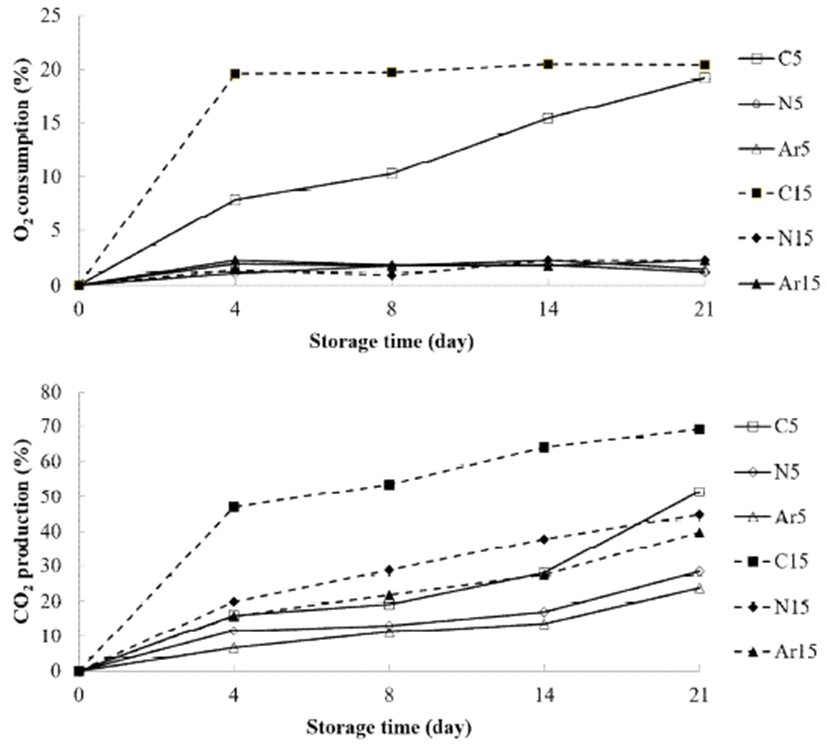
Different optimal CO2 and O2 concentrations for shiitake mushrooms have been reported in different studies. Minamida et al. (23) reported that 40% CO2 and 1% O2 prolonged the shelf life of shiitake mushroom. Parentelli et al. (24) suggested CO2 levels for shiitake mushrooms below 2%. However, our present study used a CO2 concentration of about 17% and an O2 concentration below 3% for the Ar and N MAP. Among the MAP conditions, Ar showed the lowest respiration rate, having the lowest CO2 production during storage. Utilization of Ar in MAP significantly extends the mushroom storage, as it is believed that argon limits metabolism by gas hydrate formation and residual gas in tissue, which restricts water activity and enzymes (25).
Loss of moisture in mushrooms is a degrading factor that causes detrimental effects such as tissue shrinkage, resulting in excessive weight loss (26). Fig. 2 shows the weight loss of the mushrooms under different conditions. Weight loss occurred throughout the storage time regardless of the packaging conditions employed, though the extent depended temperature and MAP conditions. Lagnika et al (26) reported that argon treatment reduced weight loss in mushroom during storage time. It is assumed that clathrate hydrate formation by high argon pressure can decrease the water loss owing to the hydrogen bonds between water molecules (26). However, there was no significant difference in weight loss between MAP conditions (p>0.05). Weight loss as a result of storage temperature was 2.84-3.7% and 5.39-6.01% at 5 and 15℃, respectively. It can be inferred from this result that weight loss is reduced at a lower temperature. The effect of high temperature on weight loss may be due to the increase in the vapor transmission rate of the film, as well as the transpiration and respiration rate of the mushrooms (27). Tano et al (28) also reported that high temperature accelerated weight loss.
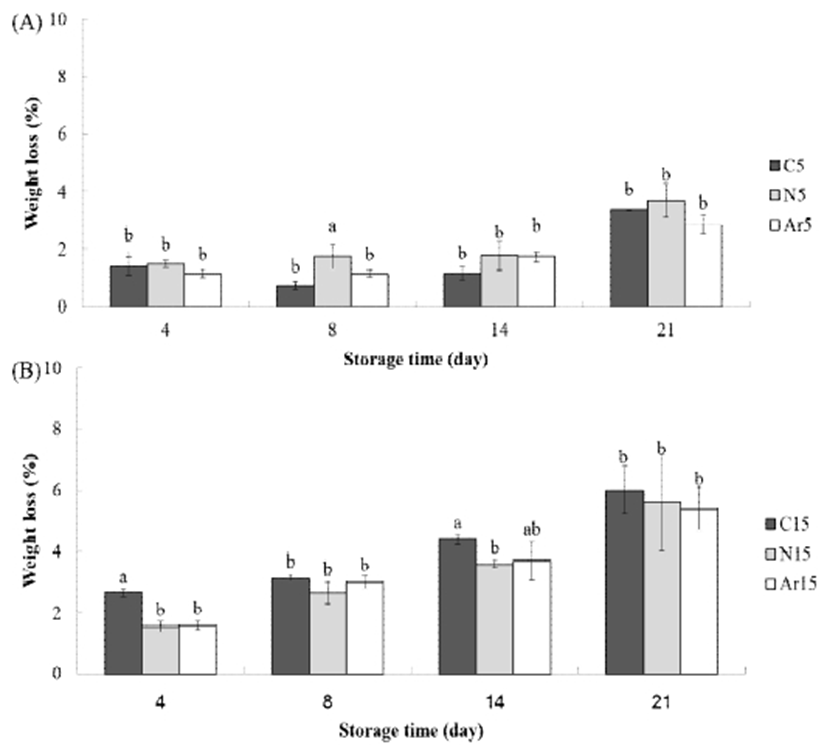
The color of a mushroom is an important factor in consumer acceptance and marketability. The color of the caps and gills were expressed as the L* value which represents the brightness of the sample. Browning in mushrooms, indicated by a decreasing L* value (29), is assumed to be a direct consequence of PPO action on polyphenols (30). Fig. 3 displays the color values of the caps and gills. The L* values of the caps and gills decreased during storage at both temperatures. However, mushroom storage at 5℃ was observed to limit reduction in L* values. The mushrooms stored at 5℃ showed the highest L* values after 21 days. Among the MAP conditions, Ar showed a higher L* value for mushroom caps than N or C MAP after 21 days at 5℃. The gas type did not affect the brightness of the gills at 5℃. However, the Ar and N MAP showed higher L* values for the gills after 14 days at 15℃.
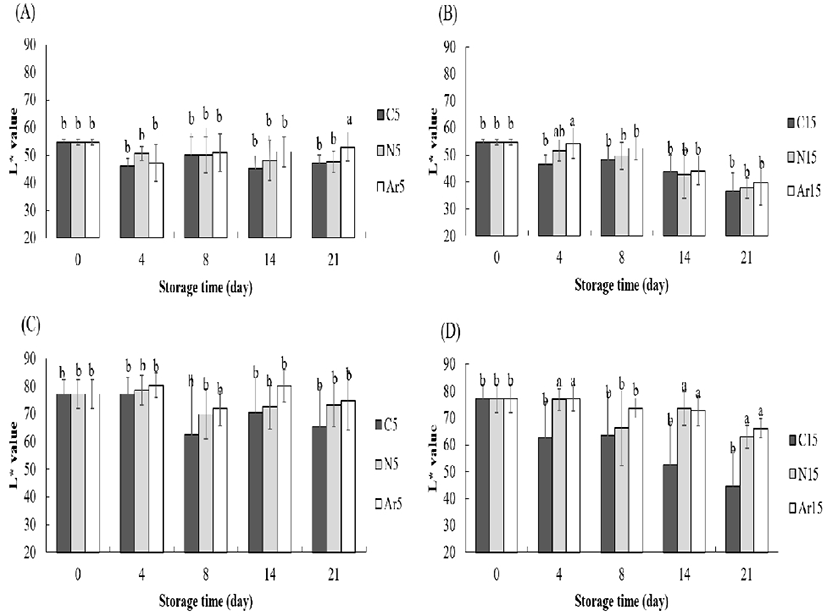
One of the main characteristics associated with mushrooms deterioration is changes in texture during storage. The influence of storage temperature and MAP conditions on the texture represented by hardness value is presented in Fig. 4. At 5℃, mushrooms stored in the Ar MAP showed higher hardness than other packaging conditions from day 14 until the end of the evaluated storage time at day 21. Similar results have been reported on the influence of argon MAP conditions in the maintenance of the initial firmness of kiwifruit (31). At a storage temperature of 15℃, mushrooms in the Ar and N MAP maintained higher hardness throughout storage than those in C packaging. The biochemical reactions responsible for mushroom tissue degradation are inhibited by atmospheres lower in O2 and higher in CO2 than air (22). Previous studies have reported that high CO2 concentrations seem to play a key role in preserving the textural properties of mushroom (32-35). The hardness of the mushrooms decreased more rapidly at 15℃ than at 5℃. A relationship between texture and storage temperature can be seen from this result, as the mushroom texture was preserved more at lower temperature. Mushroom softening or loss of hardness during storage has been ascribed to changes in the membrane (36). According to Zivanovic et al (37), texture changes are also related to protein and polysaccharide degradation, hyphae shrinkage, central vacuole disruption and expansion of intercellular space at the pilei surface.
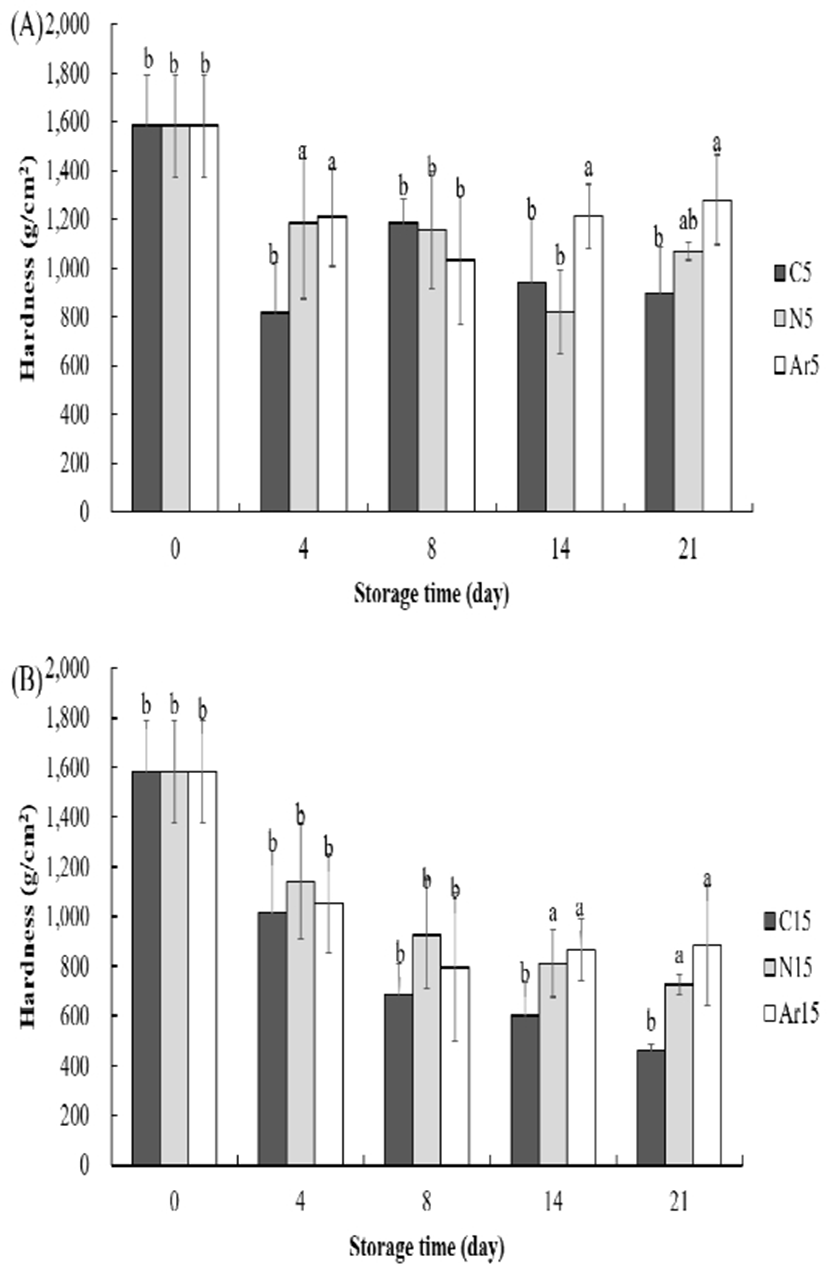
PPO is known as an enzyme related to mushroom browning (38). The PPO results as affected by the storage temperatures and MAP conditions are shown in Fig. 5. The PPO activity increased with an increase in storage temperature. There were no differences in PPO activity between MAP conditions at 5℃. However, Ar and N MAP both inhibited PPO activity at 15℃. When the mushrooms were stored at 15℃ for 21 days, the PPO activity of the mushrooms stored under C packaging increased (21.67 U/min), but those stored in Ar and N MAP were 14.15 and 12.29 U/min, respectively. Overall, mushrooms in the Ar MAP showed lower PPO activity than those in the N MAP at 15℃. A similar result was obtained by Bae et al. (39). Spencer et al. (40) claimed that the high atomic mass of noble gases facilitated the inhibition of PPO activity. O’Beirne et al (41) reported that argon was more effective at reducing PPO activity than nitrogen and suggested that the inhibitory effect of argon gas resulted from its high Van der Waals radius.
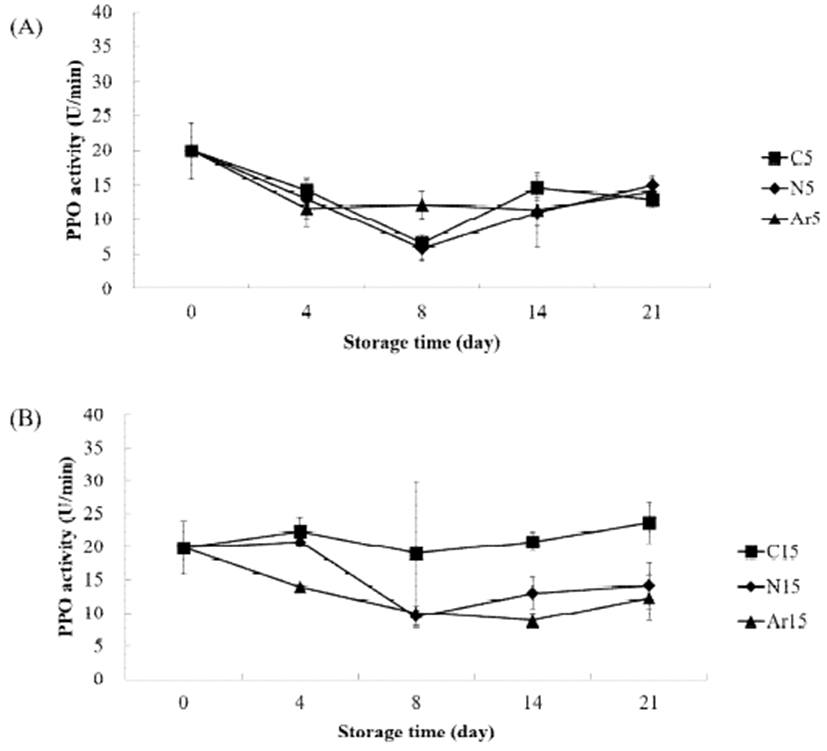
Microbial growth rate is an important parameter in food safety because it influences product qualities such as texture and freshness (42). Furthermore, toxic substances can be produced if the microbial count goes beyond 6.0 log CFU/g (43). The change in microbial growth during storage is shown in Table 2. The initial microbial count was 0.58 log CFU/g. The microbial count at 5 and 15℃, was 2.13-2.51 and 2.76-2.85 log CFU/g, respectively. Microbial growth greatly increased over 0-4 days, then decreased after 4 days. The microbial count increased with increasing storage temperature. Overall, MAP conditions did not affect the microbial growth of the mushrooms throughout 21 days of storage at 5 and 15℃, which contradicts some reports that argon had a good effect on suppressing microbial growth at low temperatures (26,44).
It is assumed that contamination might have been caused by moisture in the package due to transpiration in this study. To reduce contamination by condensed water, further study to reduce transpiration is required.
Conclusion
Mushrooms were stored under different temperatures and MAP conditions. Storage temperature greatly influenced the quality of the mushrooms. Mushrooms stored at 5℃ showed lower O2 consumption, CO2 production, decay rate, color change, and weight loss compared with those stored at 15℃. Weight loss and microbial count did not show significant differences depending on the MAP conditions. However, mushrooms stored in Ar and N MAP presented lower O2 consumption, CO2 production and decay rates compared with those stored in C packaging. Ar and N MAP inhibited PPO activity in mushroom at 15℃. Mushrooms in the Ar MAP retained hardness during storage. Mushrooms in the Ar and N MAP maintained gill brightness at 15℃. We therefore identified the Ar MAP as being effective for improving the shelf-life of mushrooms. However, moisture condensed in the package because of transpiration. That moisture might cause rapid corruption and quality loss. Therefore, further study is needed to reduce transpiration in the package.
